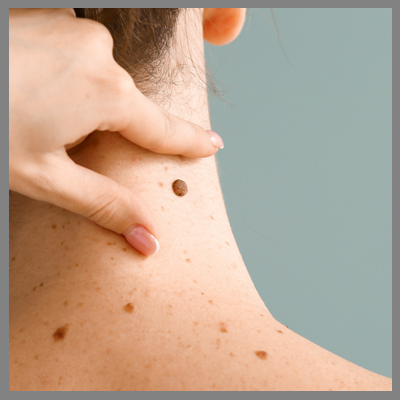

Moles are common type of skin growth. They often appear as small, dark brown spots and are caused by clusters of pigmented cells. Moles generally appear during childhood and adolescence. Most people have 10 to 40 moles, some of which may change in appearance or fade away over time.
Most moles are harmless. Rarely, they become cancerous. Monitoring moles and other pigmented patches is an important step in detecting skin cancer, especially malignant melanoma.
The medical term for moles is nevi.
The typical mole is a brown spot. But moles come in different colors, shapes and sizes:
Moles can develop anywhere on the body, including scalp, armpits, under nails and between fingers and toes. Most people have 10 to 40 moles. Many of these develop by age 50. Moles may change in appearance or fade away over time. Hormonal changes of adolescence and pregnancy may cause moles to become darker and larger.
This ABCDE guide can help one to determine if a mole or a spot may indicate melanoma or other skin cancers:
Cancerous (malignant) moles vary greatly in appearance. Some may show all of the features listed above. Others may have only one or two.
FLOURIC ACID : Useful for nævi.There is burning and itching which is worse from warmth. There is profuse, sour, offensive perspiration.
THUJA : Useful for itching and stinging moles. Useful for brown or brownish-white spots here and there;There is eruptions only on covered parts which burn after scratching.Useful for brown spots like liver spots form upon the abdomen. Useful for hydrogenoid constitution.There is rapid exhaustion and emaciation.
CALCAREA CARB : Useful for moles which is red, glistening, lenticular spot which may become bluish.Useful when Skin looks dry and pale. Useful for scrofulous constitution.There is great sensitiveness to cold.
SULPHUR : Useful for smooth, moist nevi & Birthmarks.There is brown colored mole. Useful for burning all over the body.Useful for liver spot on the back and chest. There is itching and burning of the part aggravated by washing and scratching. Useful for dirty, filthy people. There is aversion to being wash.
PETROLEUM : Useful for moist moles.There is itching at night. Useful for dry, constricted,rough and cracked skin.There is marked aggravation from mental emotions.
RL - 30